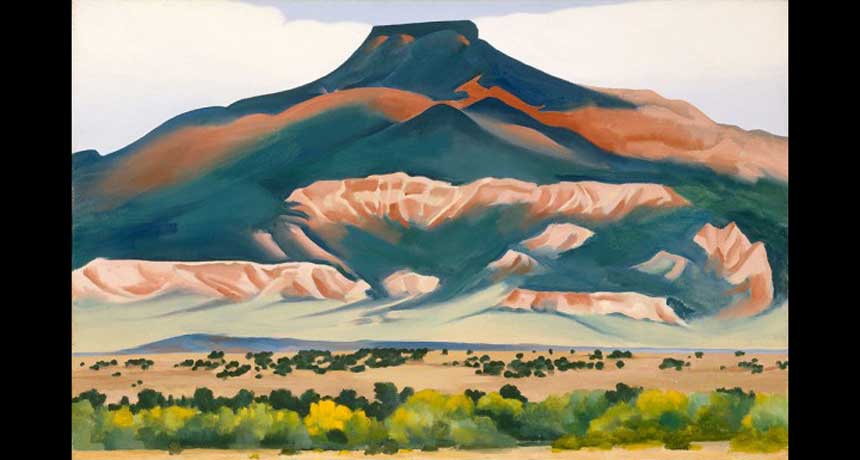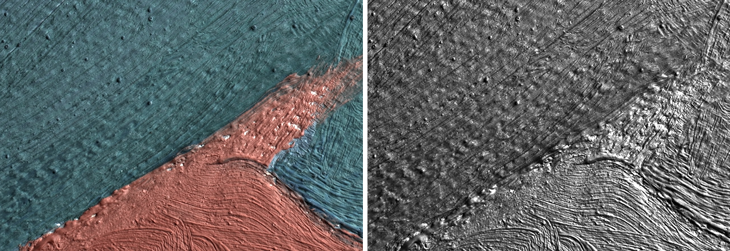Smartphone app helps researchers track art ‘acne’
Computer program lets scientists study the metal-soap zits that damage oil paintings

This oil painting by Georgia O’Keefe called “Pedernal” has zits. Researchers now know why these damaging bumps form. Chemicals in the paint have reacted to form small knobs.
Georgia O'Keeffe. Pedernal, 1941. Oil on canvas, 19 x 30 1/4 inches. Georgia O'Keeffe Museum. Gift of The Georgia O'Keeffe Foundation. © Georgia O'Keeffe Museum [2006.5.172]
By Jeremy Rehm
WASHINGTON, D.C. — Like a teen’s skin, oil paintings can break out in zits. Researchers want to prevent these flare-ups, which can damage priceless art. A group of scientists has now developed a computer program to track these bumps.
Artists and museum experts have known for many years that oil paintings can form tiny blisters. As these bumps grow, the surface paint can crack and flake off like dry skin. Georgia O’Keeffe was an early modern painter in the United States. She had noticed those breakouts on her own artwork. Some people suspected the bumps came from her studio in New Mexico. Desert sand might have mixed with her paints as she worked.
Now researchers have identified the true culprit. Chemicals in the paint react to make metal soaps. Such metal soaps form beneath the surface of some 70 percent of all oil paintings. Art experts have seen them on works by Rembrandt, Francisco de Goya and Vincent van Gogh.
“It’s not an unusual phenomenon,” says Marc Walton. This art expert is a materials scientist at Northwestern University in Evanston, Ill. Walton discussed the metal-soap problem during a press conference, here, at the annual meeting of the American Association for the Advancement of Science.
Roughly 20 years ago, scientists learned what makes metal soaps. Oil paints are a mix of fats, pigments and metal ions. The negatively charged fats can react with positively charged metal ions (such as zinc and lead). These form tiny structures known as liquid crystals. These bits eventually gather into globs that look like tiny white insect eggs. Over time, those apparent eggs slowly grow until they bulge under the paint layers. Eventually, the surface paint can tear and flake off.
Walton wants to figure out what makes these liquid crystals form. Could dampness, light or temperature make a difference? To find out, he needed to be able to study the paintings’ bumps.
He turned for help to computer scientist Oliver Cossairt, also at Northwestern. Cossairt designed a computer program. It can run as an app on a cell phone or tablet. The app will direct the device to shine patterns of light onto a section of some artwork. Then the device’s camera collects the light reflecting off the paint.
Color can camouflage the small distortions caused by the bumps. So the program strips away the color. Then the software sorts the knobby structures and separates them from other textures, such as brushstrokes. Later, the app creates a report that lists the place and size of the acne-like blisters and how they’re grouped.

It’s a bit like Star Trek’s “tricorder,” Cossairt says. That device could diagnose a human illness from a simple scan. This one diagnoses chemical “disease” in artists’ paint.
Using the computer program, the team is now studying test paintings. Each one is exposed to one factor: light, humidity or temperature. The team wants to see how the fast an artwork’s zits develop and grow under these different conditions.
It’s hard for people working in museums to identify how quickly this art acne forms. “You see paintings with this kind of knobby, bubbly surface, and you don’t know if that has happened in five years, 50 years or more,” notes Kenneth Sutherland. He works at the Art Institute of Chicago in Illinois and did not take part in this study. Imaging could help researchers watch the bubbles and learn how to control or limit them, he says.
Scientists may never fully understand how metal soaps form. But this new app could help art conservators protect iconic works of art. As new bubbles on a painting emerge, the museum could move the artwork to a safer environment.
Oil paintings may always be prone to forming these zits, Walton says. The real solution might just be finding the best way to store the vulnerable works of art.







